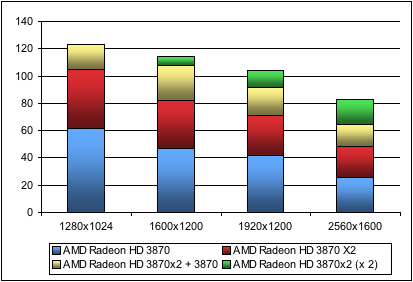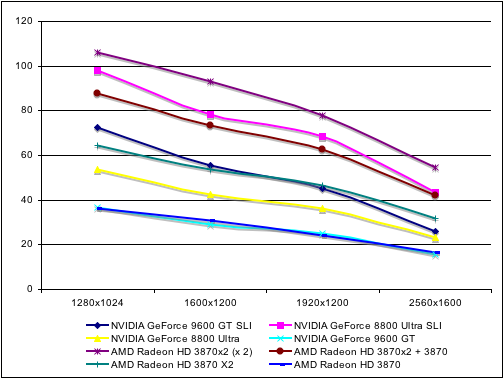CrossFireX Arrives: First Look at 3 and 4 GPUs in 2 Card Setups
by Derek Wilson on March 7, 2008 12:05 PM EST- Posted in
- GPUs
The Elder Scrolls IV: Oblivion Performance
Version: 1.2.0416 Shivering Isles
Settings: Ultra High Quality settings defaults with Vsync disabled.
Our Oblivion test takes place in the south of the Shivering Isles, running through woods over rolling hills toward a lake. This is a straight-line run that lasts around 20 seconds and uses FRAPS to record framerate. This benchmark is very repeatable, but the first run is the most consistent between cards, so we only run the benchmark once and take that number.

Our tests show that moving beyond two GPUs in a DX9 game that already benefits well from multi-GPU has the potential to make use of three or four GPUs. As resolution goes up, the usefulness of more than two GPUs goes up. Clearly, there is potential for scaling with games that don't make extensive use of features that get in the way of multi-GPU performance. It should also go without saying that this is a technology that should be reserved for the ultra high-end setups. Hopefully illustrating that with resolution scaling will help bring the point home.

| Oblivion Perfomance | ||||
| 1280x1024 | 1600x1200 | 1920x1200 | 2560x1600 | |
| NVIDIA GeForce 9600 GT SLI | 89.8 | 70.4 | 59 | 33.7 |
| NVIDIA GeForce 8800 Ultra SLI | 113.1 | 96.1 | 84.2 | 57.4 |
| NVIDIA GeForce 8800 Ultra | 59.5 | 54.4 | 46 | 31.5 |
| NVIDIA GeForce 9600 GT | 49 | 37.5 | 30.6 | 19.8 |
| AMD Radeon HD 3870X2 (x 2) | 120.3 | 114 | 104.1 | 82.8 |
| AMD Radeon HD 3870X2 + 3870 | 122.9 | 107.6 | 91.5 | 64.5 |
| AMD Radeon HD 3870X2 | 104.5 | 82 | 71.1 | 48.6 |
| AMD Radeon HD 3870 | 61.8 | 46.8 | 41.5 | 25.4 |
AMD tends to lead in this benchmark normally, and the 8800 Ultra barely leads the Radeon HD 3870, which is normally in competition with the GeForce 9600 GT. In this case, the 8800 Ultra SLI loses to the three GPU AMD setup (3870X2 + 3870), while four GPUs show an even more significant advantage at higher resolutions. 9600 GT SLI, which would normally compete with the 3870X2, doesn't really come through in Oblivion.

Enabling AA and AF reveals one of the major strengths of multi-GPU acceleration: antialiasing comes at less cost. In this case, even at lower resolutions, all four GPUs are able to contribute and performance stays high. While CrossFire and SLI both enable huge levels of AA, at high resolutions a little bit goes a long way.

| Oblivion 4xAA/16xAF Performance | ||||
| 1024x768 | 1280x1024 | 1600x1200 | 1920x1200 | |
| NVIDIA GeForce 9600 GT SLI | 72.7 | 55.4 | 45.3 | 26.1 |
| NVIDIA GeForce 8800 Ultra SLI | 98.1 | 78.5 | 68.3 | 43.3 |
| NVIDIA GeForce 8800 Ultra | 53.8 | 42.4 | 36.1 | 23.1 |
| NVIDIA GeForce 9600 GT | 36.9 | 29.2 | 25 | 15.6 |
| AMD Radeon HD 3870X2 (x 2) | 106.1 | 93.3 | 78.1 | 54.5 |
| AMD Radeon HD 3870X2 + 3870 | 87.6 | 73.6 | 62.9 | 42.3 |
| AMD Radeon HD 3870X2 | 64.4 | 53.6 | 46.6 | 31.7 |
| AMD Radeon HD 3870 | 36.4 | 30.9 | 24.4 | 16.7 |
While two 3870X2 cards do lead overall, 8800 Ultra SLI does best the three GPU combination of the 3870X2 and the 3870. Oblivion certainly shows that more than two GPUs can contribute to performance, and that AMD was right when they said DX9 games running under Vista would show the most potential for improvement with four GPU systems.










36 Comments
View All Comments
DerekWilson - Saturday, March 8, 2008 - link
that is key ... as is what ViRGE said above.in addition, people who want to run 4 GPUs in a system are not going to be the average gamer. this technology does not offer the return on investment anyone with a midrange system would want. people who want to make use of this will also want to eliminate any other bottlenecks to get the most out of it in their systems.
not only does skulltrail help us eliminate bottlenecks and look at the potential of the graphics subsystem, in this case i would even make the argument that the system is a good match for the technology.
Sind - Saturday, March 8, 2008 - link
I agree, I don't think the Skulltrail is doing anyone favours of how they could judge utilising these MGPU solutions in a "average" system that the reader on Anand would be using. X38 seems very popular as is 780i, I really don't think even more then 1% of your traffic would ever utilise the system you used to do this review. I've read the other CrossfireX reviews from around the net, and most had no problems at all, and infact most noted that it worked straight out with no messing around with the lengthy directions that were indicated in the article to get it to work.ViRGE - Saturday, March 8, 2008 - link
Something very, very important to keep in mind is that Skulltrail is the only board out right now that supports Crossfire and SLI. If AT wants to benchmark both technologies without switching the boards and compromising the results, this is the only board they can use.Cookie Monster - Saturday, March 8, 2008 - link
No 8800Ultra or GTX Tri-SLI for comparison?DerekWilson - Saturday, March 8, 2008 - link
we were looking at 2 card configurations here ... i'll check out three and four card configs laterJarredWalton - Saturday, March 8, 2008 - link
Unfortunately, Tri-SLI requires a 780i motherboard. That's fine for Tri-SLI, but CrossFire (and CrossFireX) won't work on 780i AFAIK. I also think Skulltrail may have its own set of issues that prevent things from working optimally - but that's conjecture rather than actual testing. Derek and Anand have Skulltrial; I don't.Slash3 - Saturday, March 8, 2008 - link
...graphs are both using the same image. The Oblivion Performance and 4xAA/16AF Performance line graphs (oblivionscale.png) are just duplicates and link to the same file. :)JarredWalton - Saturday, March 8, 2008 - link
Fixed, thanks.slashbinslashbash - Saturday, March 8, 2008 - link
Graphics really are fairly unique in the computing world in that they are easily parallelized. While we're pretty quickly reaching a point of diminishing returns in number of cores in a general-purpose CPU (8 is more than enough for any current desktop type of usage), the same point has not been reached for graphics. That is why we continue to see increasing numbers of pipelines in individual GPU's, and why we continue to see effective scaling to multiple cards and multiple GPU's per card. As long as there is memory bandwidth to support the GPU power, the GPU looks like it is capable of taking advantage of much more parallelization. I expect 1000+ pipes on a 2-billion-transistor+ GPU by 2011.So, I expect multi-GPU to remain with us, but any high-end multi-GPU setup will always be surpassed by a single-GPU solution within a generation or two.
DerekWilson - Saturday, March 8, 2008 - link
that's not the issue ... graphics is infinitely parallelizeable ...the problems are die size and power.
beyond a certain die size there is huge drop off in the amount of money and IHV can make on their silicon. despite the fact that every chip could have been made larger, we are working with engineers, not scientists -- they have a budget.
multiGPU allows IHVs to improve performance nearly linearly in some cases without the non-linear increase in cost they would see from (nearly) doubling the size of their GPU.
...
then there is power. as dies shrink and we can fit more into a smaller space, will GPU makers still be able to make chips as big as R600 was? power density goes way up as die size goes down. power requirements are already crazy and it could get very difficult to properly dissipate the heat from a chips with small enough surface area and huge enough power output ... ...
but speading the heat out over two less powerful cards would help handle that.
...
in short, multigpu isn't about performance ... it's about engineering, flexibility and profitability. we could always get better performance improvement from a single GPU if it could be built to match the specs of a multiGPU config.